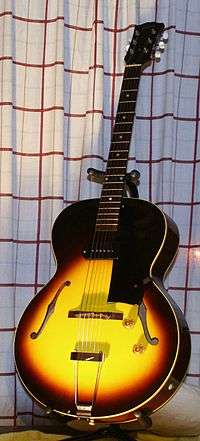Gibson ES-125
| Gibson ES-125 | |
|---|---|
 A 1955 Gibson ES-125 with a P-90 | |
| Manufacturer | Gibson |
| Period | 1941-1970 |
| Construction | |
| Body type | Hollow |
| Neck joint | unknown; presumably set |
| Woods | |
| Body | unknown; presumably mahogany |
| Neck | unknown; presumably maple |
| Fretboard | Rosewood |
| Hardware | |
| Bridge | Tune-o-matic |
| Pickup(s) | 1 P-90 |
| Colors available | |
| Sunburst | |
The Gibson ES-125 is an archtop, hollow body electric guitar model that was produced by the Gibson Guitar Corporation.
Model history
Introduced in 1941 as the successor to the ES-100, the ES-125 was an entry-level archtop electric guitar. It had one P-90 single-coil pickup in the neck position, a single volume control and a single tone control. The pre-war model, discontinued in 1942, had a smaller 14.5" body. When reintroduced in 1946 it had the larger 16.25" wide body that the ES-150 had. The unbound rosewood fingerboard initially sported pearl trapezoid inlays; later, it would have dot inlays.
In the mid-1950s, the ES-125T was introduced, which was an entry-level thinline archtop electric guitar based on the original ES-125. It would later add options for double P-90 pickups and a sharp cutaway, referred to as a florentine cutaway, similar to the ES-175. Both the thinline and the regular models would be discontinued by the 1970s.
Notable ES-125 players
- Tracy Chapman [1]
- Bill Frisell [2]
- BB King (early '50s)
- Jeff Mangum
- Jim O'Rourke [3]
- Marc Ribot [4]
- Daniel Rossen
- George Thorogood
- Richard Clark [5]
- Martijn van Iterson [6]
- Thom Yorke [7]
Specifications
1946
- 161⁄4" wide
- Approximately 3.5" thick body
- Scale length 243⁄4
- One non-adjustable P-90 pickup with "dog ears"
- Pickup in neck position
- Tortoise grain pickguard
- Trapeze tailpiece
- Single bound top and back
- Pearloid circular fingerboard inlays
- Silkscreen logo
- Sunburst finish
1948
- Dot fingerboard inlays
1950
- Plain tailpiece
- P-90 pickup with adjustable poles
Pickups and Components
The ES-125 was equipped with one P90 pickup. The original had 6 Alnico slug pole pieces. In 1950 the P90 transitioned to 6 adjustable poles between two Alnico 5 bar magnets.
The model used for the ES-125 has a string spacing on the neck pickup of 115⁄16" from high E to low E. The ES-125 also used a tapered dogear cover for their neck position pickups with a thickness of 4/16" on the treble side and 5/16" on the bass side. Since the fingerboard sits flush to the body (as opposed to an ES-175) the ES-125 requires a shorter neck pickup than a typical dogear. This pickup is, however, not as short as those found on an ES-330TD which has the pickup mounted flush to the end of the fingerboard.
Coils were wound to approximately 10,000 wraps although DC resistance of these pickups can vary greatly
Volume and tone controls were 500k Audio taper pots. A treble bypass cap value of .022 microfarads was used for the tone circuit. D (Double Pickup) models included a 3 position toggle switch to select each pickup individually or both pickups simultaneously.
Models
- ES-125 Full body archtop with single P-90 pickup
- ES-125T (T = Thinline)
- ES-125TC (C = Cutaway)
- ES-125TCD (D = Double p90 pickups) versions available starting in 1956 and 1960, respectively.
- ES-125TD (D = Double p90 pickups) with (T = Thinline) body, (very rare only 320 made 1958)
- ES-125C Full width body with cutaway
- ES-125D Full width body with double p90 pickups (very rare)
- ES-125CD Full width body, double pickup (P-90) with cutaway. Looks like the ES-175D without neck binding
External links
References
- ↑ Inc., Equipboard. "Tracy Chapman's Equipboard". Equipboard.
- ↑ "Bill Frisell: Made to Shine".
- ↑ kazzniki (25 December 2013). "2013.12.25 Jim O'Rourke / Chistmas Day" – via YouTube.
- ↑ "Marc Ribot by David Krasnow - BOMB Magazine". bombmagazine.org.
- ↑ "BVStrings".
- ↑ Martijn van Iterson (23 February 2017). "Martijn van Iterson & Peter Bernstein" – via YouTube.
- ↑ "Thom Yorke's Rig". thekingofgear.com.